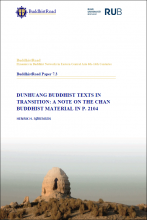BuddhistRoad Paper 7.3 "Dunhuang Buddhist Texts in Transition: A Note on the Chan Buddhist Material in P. 2104"
Synopsis
In this short essay, a single composite manuscript from Dunhuang has been selected for closer scrutiny with the purpose of identifying and discussing the Chan material it contains, as well as to account for the textual context in which it is found. To this end P. 2104 has been chosen, not only for its representational value but also because it features a variety of individual materials of considerable interest. A review of the contents of P. 2104 reveals that although the manuscript lacks an overall structure and is without inner coherence and organisational logic, it primarily consists of material relating to Esoteric Buddhist (Chin. mijiao 密教) ritual practices as well as Chan Buddhist (Chin. chanzong 禪宗) verses and didactical songs. The Chan material reflects what may be referred to as late Tang (618–907, 唐) to Five Dynasties (906–978, 五代) developments, and as such provides us with information on how a special type of Chan texts appeared in the transition between the later developments under the Tang and the period of formalisation and standardisation that characterises Chan Buddhism during the Northern Song (960–1126, 北宋). Lastly, it shows the manner in which Chan texts of this kind were used by practitioners living in Dunhuang during the Guiyijun (851–1036?, 歸義軍, Return-to-Allegiance Army) period.
Chinese Translation
本文选取了敦煌文书中的一份复合写本进行研究,以期识别和探讨其中包含的禅宗材料,并说明其文本背景. 之所以选择P.2104,不仅是因其所具有的代表性价值,还因其涉及多种值得关注的独特材料. 对P.2104的研究表明,尽管该写本既无整体结构,也无内在连贯性和组织逻辑,但其主要内容涉及密教实修与禅诗偈语. 这些材料反应了禅宗从唐(618–907)晚期到五代(906–978)的发展,也说明了从晚唐到北宋(960–1126)——禅宗逐渐正规化和标准化的过渡时期——这一特殊的文本类型是如何出现的,与此同时,其也展示了归义军(851–1036?)时期居于敦煌的修行者们使用这类禅诗偈语的方式.

Downloads
Published
Categories
License

This work is licensed under a Creative Commons Attribution-NonCommercial-NoDerivatives 4.0 International License.

